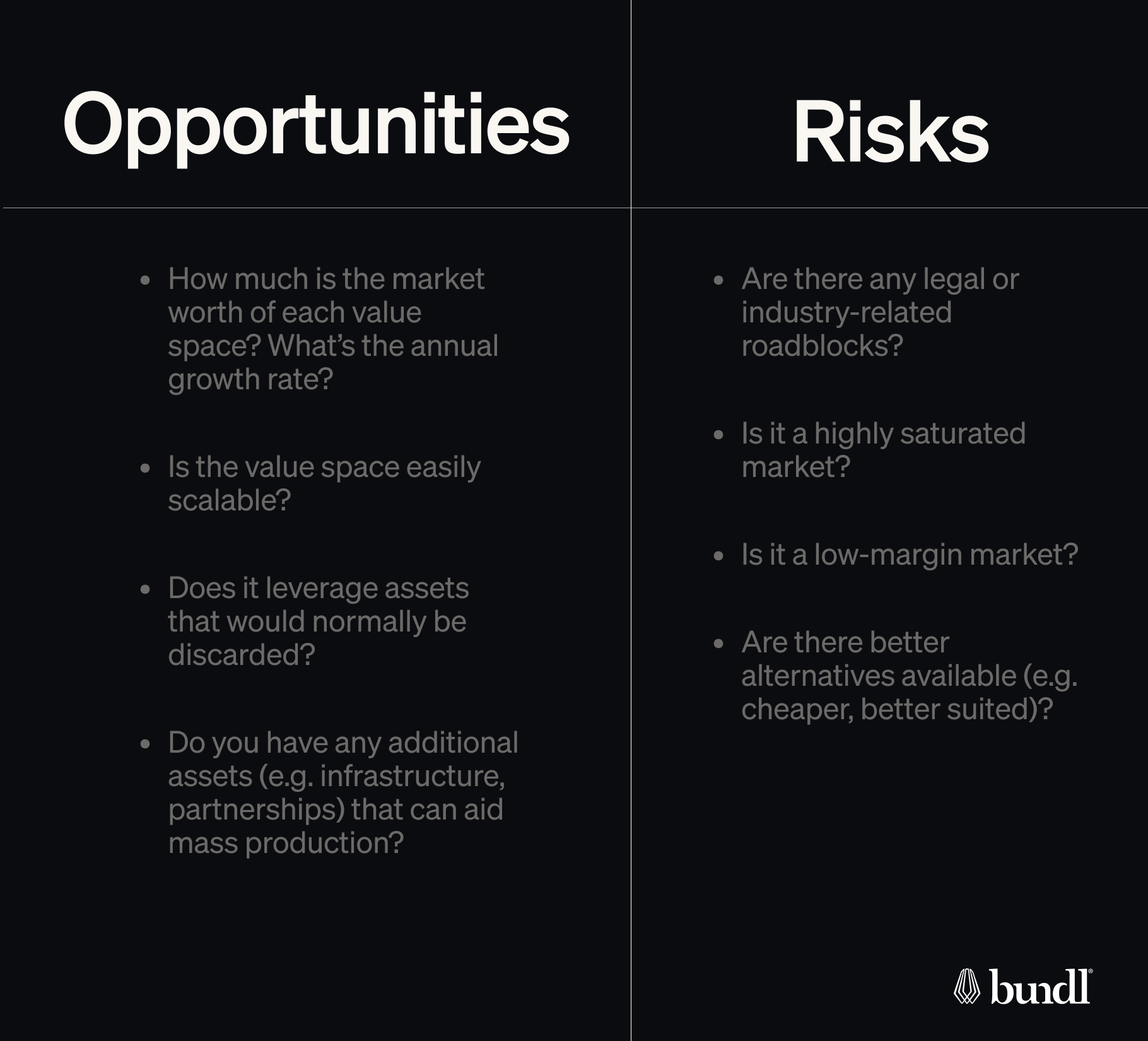Key takeaways
To stay ahead in today’s fast-moving and ever-changing landscape, companies must continuously identify and explore new value spaces outside their core business. It’s one of the most effective ways to future-proof your business, enabling you to:
- Tap into new markets
- Test new business models and technologies
- Leverage existing assets to create new revenue streams
- Compete more effectively
Traditionally, the goal of identifying new value spaces was mostly achieved through brainstorming, market research, and ideation. This, in turn, led to a long list of possibilities ranked on the basis of several factors, including market size, customer trends, technology trends and the competitive landscape (just to name a few). The areas with the highest potential then get chosen for validation.
While there’s nothing wrong with the traditional approach, we’ve come up with a faster and more efficient way to get the job done: Innovation bricks. This methodology makes it possible to identify value spaces in a more systematic, structured and effective way, making the most of your existing assets and giving you a solid foundation for future venturing activities.
Ready to get started? We’ve outlined the different steps involved in this technique below. But first, a bit of context.
What are innovation bricks?
Innovation bricks are new or even existing capabilities you build within your company, enabling you to identify and expand into new value spaces. They facilitate core, adjacent and radical growth based on your existing corporate assets and capabilities.
The innovation brick technique essentially involves identifying new applications for your existing assets and capabilities. The goal? To turn them into new revenue streams.
By using your existing or new capabilities as a starting point to identify new value spaces (i.e. opportunities for growth), you can cut down the traditional ideation process and come up with new concepts quicker, based on capabilities you already have. Here’s an example of how this technique works in practice.
Step 1: Map out your existing corporate assets and capabilities
Knowing the assets and capabilities you have readily available is the first and most critical step in the process. Make sure you have a clear accounting of your tapped and untapped assets - then focus on the ones that can bring the most value.
For example, let’s say you’re a global malting company, and some of your key assets include malt, rootlets and husk. Malt would be a tapped asset that enables you to play in the value space of “breweries” and “whiskey distilleries” (probably your core offering).

Your leftover rootlets and husks would be examples of untapped assets.
Step 2: Use existing assets and capabilities to identify your innovation bricks
Now that you’ve mapped out your assets, it’s time to translate them into new capabilities (aka innovation bricks).
Continuing on the example above, a little research will reveal that your malt, rootlets and husks can be turned into “mycelium”, the rootlike structure of a fungus that can be used to make bio-packaging, fish-feed, vegan leather, and vegan meat.

In this case, mycelium would be your newly identified innovation brick, opening up the possibility of four new value spaces.
Step 3: Identify your key opportunities and risks
Now that you’ve identified a few new value spaces, it’s time to take a closer look at each one and identify some of the key opportunities and risks associated with each. Here are just a few examples of the questions you could ask:

The goal is to assess each market's attractiveness, so you can decide if it’s worth pursuing.
Step 4: Evaluate and prioritise
Based on the information gathered in step three, you can compare each of your newly identified value spaces and prioritise them based on how well they fit your assets, budget, timeline and growth goals.
It's okay to prioritise several value spaces because, in most cases, the development of a new capability or brick will require you to play in several value spaces.
Other factors to consider in the prioritisation process include potential impact, feasibility and alignment with your overall corporate strategy.
Step 5: Scout for strategic partners
While building a new venture from scratch has plenty of benefits, when exploring new domains, strategic partnerships tend to be faster, less risky and more efficient. For the purposes of this article, we’ll focus on the latter approach.
Start by exploring one value space - if it turns out to be a less-than-desirable opportunity, you’ll still have three additional options that might be a better fit (e.g. hits the revenue targets you were aiming for).
Finding partners within your chosen value spaces is a great way to accelerate your progress and get to know the market better. Building on our global malting company example, some potential strategic partners for the mycelium innovation brick might include startups like:
Based in Barcelona, Libre Foods makes sustainable and nutritious foods from mycelium bacon and burgers.
Meati is a startup that makes mycelium-based steak that grills and sears just like the real thing.
Together, you can start building prototypes or minimum viable products (MVPs) to see how they perform in the market.
Closing thoughts
Remember, not all of the value spaces you've identified will automatically translate into profitable growth and revenue streams. It takes a lot of research and testing to pinpoint the right areas, and even then, there will be plenty of tweaking and iteration involved.
The steps outlined above are meant to guide your journey and help you unlock new sources of value by leveraging your existing assets to their fullest potential. With a bit of persistence and a touch of luck, you may very well end up with two or three winning concepts that can be scaled up to profitability. So keep at it, stay focused, and don't be afraid to take calculated risks.
_____
Want to identify untapped value spaces in your industry and beyond? We can help you gain a clear view of how to expand outside your core offering, leveraging your existing assets to fuel growth and create new revenue streams.
16 strategies for disruptive innovation.
These 16 corporate venturing tools will help you innovate at startup speed.








